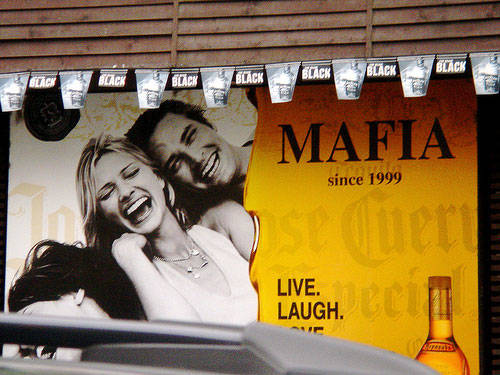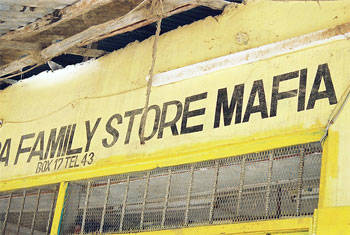The Unmaking of the Made Men of Sicily?
Rome – Finally, a sincere word of praise for beleaguered Italy. As the Indian mystic in E.M.Forster’s Passage to India said to Dr. Aziz, on trial for molesting an English maiden but acquitted thanks to his accuser’s own, unexpected testimony, “Who’d have thought that your enemy would be the one to save you?” In this case the welcome words showing Italy at its best came from a cell in Palermo’s l’Ucciardone prison. The room was bugged, but last summer one of the bosses, recently returned from 20 years in the U.S., Francesco Inzirillo, had visitors, his sons Giovanni and Giuseppe. Francesco, the man nicknamed “ù truttaturi” (my guess is the name means Il Trittatore, The Chopper), let himself go with a lament that literally thrilled the eavesdropping police of Palermo. “They’ve got our names on their list, we’ve got to get out of Sicily, out of Italy, we gotta get out of Europe. You have to go to, oh, Central America, South America,” he said, “a long way from here…”
Too late. On February 9 some 300 police made a sweep of Palermo, arresting 19 alleged Mafiosi (the New York Times gave the number as 23) while at the same time, albeit not strictly in conjunction with their U.S. allies, or so they say, the FBI indicted 80 in New York, reportedly including the entire Gambino family hierarchy. Many of those arrested on the U.S. side were connected to the trucking industry and heavy construction.
The reaction in Italy has been justifiable pride and enthusiasm, with Sicilian police saying that the Cupola—that Mafia board of directors—has been wiped out. At the very least, an attempt to relaunch the particularly brutal Sicilian Mafia’s control over a huge portion of the international drug market has been nipped in the bud.
The Sicilian Mafia has had several such historic moments, worth—I hope—reviewing quickly, so as to understand what may happen in the future.
The prewar Sicilian Mafia was agrarian. The threat of violence mattered more than the number of haystacks burnt or men murdered. The Mafiosi, middlemen between town and countryside, dined on red wine and fellowship and sausages while meting out traditional justice.
During World War II the contraband opportunities, thanks to the Allied occupation with its PX goodies, attracted country-bumpkin Mafiosi, who created newly sophisticated clandestine networks. The famine that swept Sicily in 1947 brought more of the unemployed and hungry to Palermo, easy prey.
The postwar building boom of the 1950’s provided enormous opportunities which the Palermo city powers-that-be did not fail to exploit. It was mostly about building permits, but a Mafia firm had the first on-site lunchroom for construction workers; and when a Sicilian nobleman refused to sell his family home on Viale della Libertà to buyers planning a big apartment block, the house was simply blown to smithereens. Court acquittals were the rule when alleged Sicilian Mafiosi went on trial close to home. The Church, resisting Marxist atheism and an aggressive Communist party, fumbled into a virtual alliance with politicians working hand-in-hand with mobsters.
In 1968 a huge, serious sweep headed by the then-General Carlo Alberto dalla Chiesa radically cut back Mafia power. Many, including Liggio, fled to North Italy, where they discovered kidnapping for profit and drug refining, which then bankrolled the mobsters’ return and the Sicilian Mafia’s taking over from Marseilles as capital of the drug traffic after 1978, following President Nixon’s “war on drugs,” which curbed the Marseilles-Istanbul connection, unleashing one much worse.
Initially the heroin profits seemed so immense that a pax Mafiosa was in place. Everyone had fun. Forget the godfather: this was the New Mafia, all Champagne and amusing torture and high-stakes poker and fancy restaurants and acid baths for children and, for the first time, Kalashnikovs. A certain portion of the port of Palermo, notoriously filled with skeletons, was known as Mafia Cemetery. The French chemist who could convert 1 kg of opium base into 1 kg of heroin earned $1 million for every three-day stint in a heroin kitchen at Taormina or Cefalu.
The so-called New Mafia’s murderous war over control of the heroin traffic to the U.S. peaked in 1982, when Carlo Alberto Dalla Chiesa, once again in Sicily as its top police officer, was murdered. Two rival alliances had been formed, and nine members of the Buscetta family, including Tommaso’s two sons, were killed in the heroin feud. Like the Buscettas, the Inzirillo clan was among those under assault from the rival Corleonesi, headed by Luciano Liggio, with Bernardo Provenzano and Totò Riina as backups. To escape Corleone wrath, Francesco Inzirillo—that Francesco whose unwitting compliments to the Italian police were overheard in his cell—quietly disappeared from Italy into the safer wilds of New Jersey.
Times must have grown tough there, too, however, for in 2003, just five years ago, Francesco and several of his fellow Inzirillo males on the make, nostalgic for those good old 1980’s days of really big money, began to slip back home. They made a show of being bold, moving right into their old home in Palermo’s Passo di Rigano, the modern quarter pitched on the lower slope of Monte Cuccio. Needless to say, everyone who counted knew the Inzirillos were back, to the point that Francesco himself eventually found himself in prison (one wonders which Palermo tribe led police to him).
During the two decades Francesco whiled his time away in New Jersey, radical changes took place affecting the economic, military and social subculture specific to the Mafia of Western Sicily. The age of easy acquittals and terrified juries was over. Introducing a shining new age for Sicily, the two-year-long “Maxi-trial,” whose 474 indictments were drawn up by the anti-Mafia pool of magistrates under Giovanni Falcone, had brought 360 convictions. Not all was wine and tarallucci: within three years of the Maxi-trial in Palermo only 60 of those convicted remained behind bars, but even so, the atmosphere had changed. Palermo had an anti-Mafia mayor, Leoluca Orlando. The Church had an outspoken anti-Mafia archbishop of Palermo, Salvatore Cardinal Pappalardo, who died in 2006 after 26 years of generous, devoted duty. Civic groups like the Comitato delle Lenzuola, which hangs white sheets from balconies to show their rejection of the concept of the Mafia, sprang up after the murder of Judge Falcone, and have battled on. Courageous police and magistrates have taken the places of those gunned down or, like Falcone, blown up. Successful prosecutions related to the maxi-trial took place in Paris and in New York.
The battle against the Mafia was fought on the grass-roots level, including in the schools. Students continue to make pilgrimages to the tree still growing in front of the fairly anonymous apartment building where Falcone lived. The youngsters attach letters to the tree, like this, signed “Selene,” one of many on line at www.palermoweb.com:
Feb. 2, 2008. I’m a girl, age 12, and I find myself by chance writing to thank Giovanni Falcone for having donated his own life and not having given up to the dangers his work meant, for his passion and his desire to defeat Mafia crime. Words escape me. I’m from Catania and at school we are talking about the ‘Mafia problem’. Quite often at school I see kids laughing and joking about the Mafia, but for me this is unjust.
This left the vestiges of the old guard in Sicily with little choice but to turn back to the customary but more modest urban pursuits, beginning with systematic extortion. They looked longingly at the prospects for gigantic public works which, in Catholic Church parlance, just might be occasions of sin (think: bridges). But even here there were problems, for in Sicily industrialists and businessmen began to organize to refuse to pay for protection. What was to be done?
When the once-despised Inzirillos began to return to Sicily from New Jersey, the Mafia powers-that-be in Palermo were tolerant, even welcoming. As La Repubblica explained it: “The truth is that everyone—those who did not want them [the Inzirillo clan] back in Sicily and those who wanted them—sensed that, through them, and above all through their American cousins, new business prospects, new economic and financial opportunities would open up. It seemed an extraordinary opportunity for Cosa Nostra, which was suffering from a liquidity crisis, and out of the leadership of international crime for many years. The Sicilian bosses rediscovered America, and they sent their most trusted men to the US.”
That rediscovery is at an end, everyone seems to agree, at least momentarily. The problems persist: new boys had muscled in on the drug trade—Albanians and Chinese and Russians—but some of the new crowd were Italians, including Camorristi families from Naples once allied to the Sicilians, but now operating, and wildly aggressively, on their own. The number of mob-related murders is showing a tendency to increase: today one out of every five violent deaths is mob-attributable. The traffic in mob-controlled human beings and in weapons continues, as do male, female and child prostitution, the recycling of money, illegal betting, usury and rackets, the manufacture of fakes of everything from handbags to machine tools, and the ecomafia, to name only a few. Any business, after all, can be mob business.
A prophecy made in the late 1980’s by Tommaso Buscetta, who was accompanied from Brazil to testify in Palermo at the maxi-trial by that same Gianni De Gennaro now spearheading the effort to cure Naples of its mob-related, 15-year-long garbage disposal crisis, tells the rest of the story. “When Cosa Nostra loses its protection from the state, it will become a criminal organization just like any other, and its history will be at an end.” Is this happening?
It is certainly evolving, but so is everyone else. Most recently, the ‘ndrangheta of Calabria—difficult to penetrate, still mysterious—seems to have taken over leadership in the Italian share of the drug trade. Grim statistics show relative stature: in 2005 eleven murders were attributed to the Sicilian Mafia, whereas in Calabria that same year saw twice that (23). The situation in Calabria is of sufficient concern that a magistrate has ordered viaducts and bridges to be inspected for safety because mob-connected builders may have used mushy, cheap cement instead of what the region paid for.
In all Italy, garbage-strewn Naples is considered the city most vulnerable to organized crime activity, with Mafia-style association alleged for 220 individuals out of every 100,000. Reggio Calabria follows, and only then, in third place, Palermo, the city which Francesco Inzirillo said his own people should quit because no longer a suitable place for a good mobster to hang out. That, at least, is progress.





































i-Italy
Facebook
Google+
This work may not be reproduced, in whole or in part, without prior written permission.
Questo lavoro non può essere riprodotto, in tutto o in parte, senza permesso scritto.